Valeriana, ValerianBaldrain; Phu (Classical name)Tagar (Indian Valerian, Ayurveda) Asaroon (Indian Valerian, Unani) Xie Cao 缬草(TCM) |

|
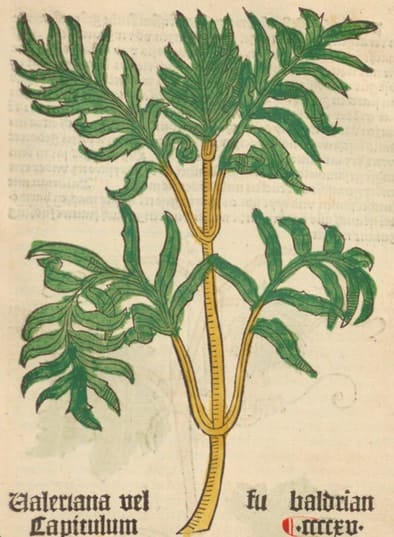 Gart der Gesundheit, Cuba, 1485
Gart der Gesundheit, Cuba, 1485 |
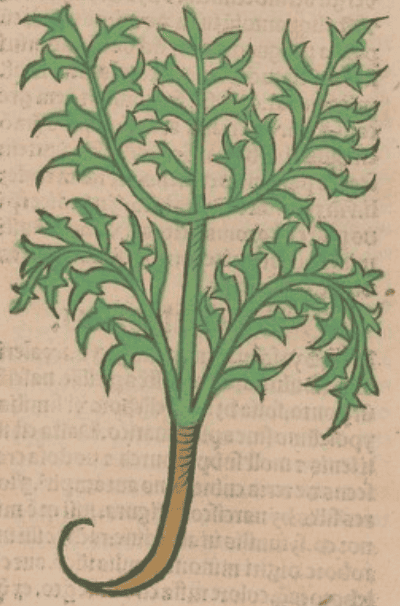 Ortus Sanitatis, Meydenbach, 1491
Ortus Sanitatis, Meydenbach, 1491 |
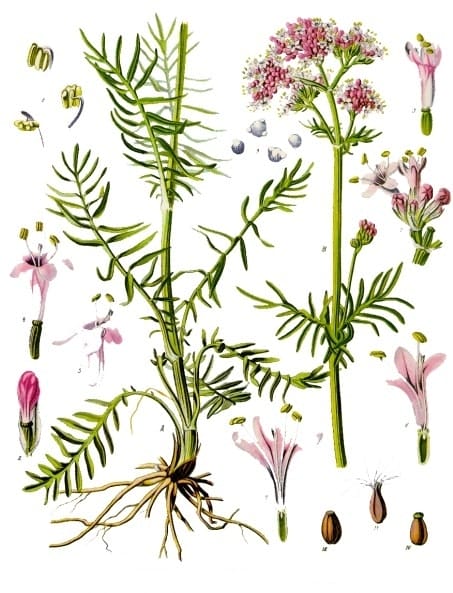 Köhler’s Medizinal-Pflanzen, 1897
Köhler’s Medizinal-Pflanzen, 1897
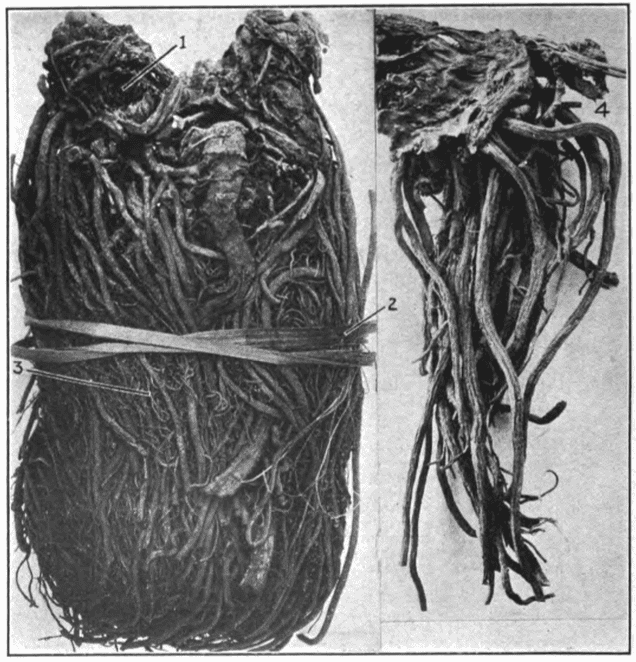
|
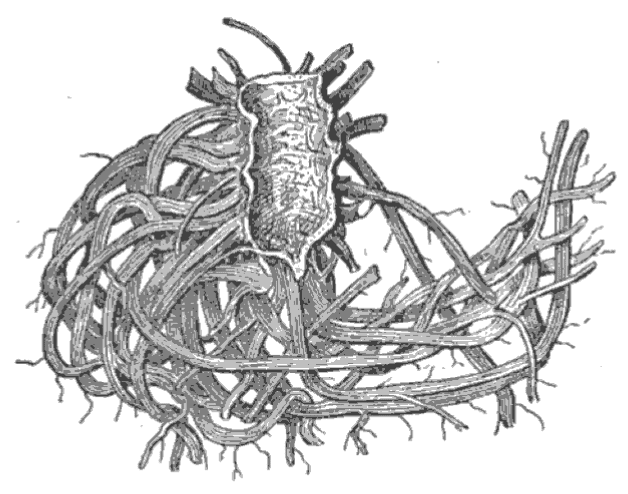
|
|
VALERIAN ROOT 1. Stem scar of valerian and folded roots. 2. Double band of grass. 3. Mass of roots. 4. Split rhizome and the large roots of Belgian valerian (Squibb’s Atlas of the Official Drugs, Mansfield, 1919) |
VALERIAN ROOT Notes on Pharmacognosy, Otto Augustus Wall, 1902 |
Botanical name:
Valeriana spp.
Two main species are used:
- V. officinalis
- V. wallichi (syn. V. jatamansi), V. hardwickii, ‘Indian Valerian’, used in Ayurveda, Unani, and rarely in TCM)
Great Garden Valerian was called Phu magnum, the Wild, Phu parvum
Parts used:
Root
Temperature & Taste:
Warm, dry. Pungent, aromatic
“Hot and Dry in the Third degree. However, Dryness is claimed by some to be less than its Hotness”. (Avicenna)
Classifications:
2A APERIENT. 2H. CARMINATIVE. 2I. ANTISPASMODIC
3C. ALEXIPHARMIC. 3D. CORDIALS & CARDIACS. 3E. DIURETIC. 3G. EMMENAGOGUE
4b. OPTHALMIC. 4f. SPLENETIC. 4i. UTERINE
Uses:
1. Moves the Qi, Settles Wind and Spasms, Calms the Mind and Spirit (West, TCM, Ayurveda):
-“excellent against nervous affections such as Headaches, Trembling, Palpitations, Vapours, and Hysteric complaints”. (Culpeper)
-Migraine, Delirium Tremens, Vertigo, Epilepsy, Neuralgia, Convulsions
-Neurasthenia, Apprehension, Insomnia, Anxiety, cramps etc.
-more recently for childhood Behavioral and Learning disorders
-Depression associated with excess Worry, Phobias, and Paranoia in adults.
-Cerebral Anemia with Depression and Despondency.
-“It is highly useful in obstructions and hardness of the Liver”. (Avicenna)
-“deobstruent and its consumption gives relief in all internal Pains”. (Avicenna)
2. Moves the Qi and Blood, Promotes Menstruation:
–irregular and painful menstruation, Hysteria (since Dioscorides)
-excellent for hysteria or nervous disorders related to Menopause.
3. Moves the Qi, Promotes Digestion:
-it may be used as a carminative in Colic and Griping.
-Cold and Damp from the Stomach, promotes appetite, and has been used for chronic constipation in nervous individuals with good results.
-stomach pain from Cold and Qi stagnation (TCM)
4. Warms the Kidneys, Clears Wind and Damp, Promotes Urine:
-“a most singular medicine against the difficulty of making water, and the Yellow Jaundice”. (Gerard)
-difficult, painful urination (since Dioscorides)
-“strengthens the bladder and kidneys, facilitates urination”. (Avicenna)
-“Stir up Lust” (Culpeper); “Promotes formation of Semen” (Avicenna)
-Sciatica, Hip pain (Avicenna)
-Arthritis and Rheumatism; the related Indian variety is said to clear Ama (Damp) from the Joints.
-“it warms up cold organs”. (Avicenna)
5. Moves the Qi and Blood, Benefits the Heart:
-Arrhythmia’s, Angina Pectoris and Hypertension associated with nervousness and anxiety.
-‘Comforts the Heart’; Tachycardia that happens just before sleep; Palpitations with Insomnia
-regulates the Heart and is a useful Cardiotonic.
-also difficult or labored Breathing
6. Clears Wind, Resists Poison:
-‘put into counter-poisons and medicines preservative against the Pestilence’ (Gerard; since Dioscorides)
-both a preventative and treatment for Epidemic disease
-counter-poison for various toxins and venoms including toxic food and poison herbs, as well as the bites of poisonous insects and animals.
-similarly in TCM, especially to prevent and treat Influenza.
7. Externally:
-“It is used generally in slight Cuts, Wounds, and small Hurts”
-used also for Bruising and pain from Trauma
-used to draw out Thorns, Splinters etc. from the flesh.
-the oil is used topically for Neuralgia and Paralysis.
-the powdered root used as a snuff for weak Eyes.
-opacity of the Cornea (Avicenna)
Dose:
POWDER: 1–3 grams;
DECOCTION: 3–9 grams;
TINCTURE (1:3 in 45% alcohol): 3–15mls.
Comment:
Valerian is a good regulator of the CNS. In Ayurveda it is said to balance the 5 Vayu (5 main types of Wind or Qi). When they are erratic it settles and stablizes Qi, when sluggish or stagnant it moves Qi. It opens and relaxes the channels to allow Qi to flow smoothly. It is quite warm, so in itself is more suited to Cold-Damp-Phlegm conditions. However, it can still be used for Hot-Pitta-Bile disorders with reduced dosage and in combination with appropriate cooling medicines.
Substitutes:
1. Indian Spikenard and Valerian and considered fairly synonymous. They may substitute one another. “It is similar to Nard [Indian Spikenard] in many respects”. (Avicenna)
2. Indian Valerian (Tagar) is obtained from V. wallichi and is used synonymously
3. Cryptocoryne spiralis has been used as a substitute for Tagara in Ayurveda.
4. Ayurvedic texts state that when Tagar (Indian Valerian) is unavailable, Costus can be used.
5. Patrinia scabiosaefolia of Japanese origin was sometimes sold on the London market as a substitute for Valerian; it was said to have an odor and smell very similar to Valerian. (Pharmacographia, Fluckiger & Hanbury, 1879)
Main Combinations:
Valerian combines well with Calamus. Both are warm, dry and aromatic, move Qi, and open the Orifices of the Mind. Valerian is heavy, and settles Wind. Calamus is lighter and clarifies the Mind. Together, they regulate Qi flow to the Mind, clarify consciousness while promoting calmness and relieving anxiety. Calamus is useful to negate the heavy, dulling effect of Valerian.
Brain and Nerves
1. Wind diseases of the Head:
i. Valerian with Peony (as in Powder for Epilepsy of Quincy)
ii. Valerian with Peony and Mistletoe (as in Electuary for the Head)
iii. Valerian with Peony, Mistletoe, White Dittany (as in Powder for Epilepsy of Lewis)
iv. Valerian with Peony, Calamus, Mistletoe, Sage, Betony, Marjoram, Rue, Juniper berry, Rosemary, Lavender (as in Cephalic Decoction)
2. Spasms, Anti-spasmodics:
i. Valerian (20 parts), Cinnamon (3 parts). (Formulaire Pharmaceutitique a l’usage des Hospitaux Militaires de France, 1821)
ii. Valerian with Rosemary, Sage, Serpentaria (Pharmacopee Usuelle, Louvain, 1821)
iii. Valerian (3 parts), Orange leaf (2 parts), Yarrow (1 part). (Pharmacopoeia Herbipolitania, 1796)
iv. Valerian (1 scruple), Camphor (1 grain). Take as a dose. (Pharmacopoeia Militaris, 1818)
v. Valerian, Crab’s Eyes, Deer horn shavings, Mistletoe (equal parts). (Armen Pharmacopoea, Hufeland, 1825)
vi. Valerian (1 oz.), Zinc oxide (1 scruple), Musk (10 grains). (Picettario Clinico, Padua, 1825)
3. Epilepsy:
i. Valerian with Orange peel
ii. Valerian (½ oz.), Orange leaf (1 dram), Cajeput oil (32 drops). Mix, divide into 6 doses. Take 1 portion 3 times daily. (Sobernheim, 1840)
iii. Valerian (10 parts), Cinnamon (3 parts), Simple Syrup sufficient to form a bolus. (Formulaire Pharmaceutitique a l’usage des Hospitaux Militaires de France, 1821)
iv. Valerian with Orange leaf, Wormwood
v. Valerian with Mistletoe, Peony root, Orange flower (Kroeber)
vi. Black Cherry Water, Lime flower Water, Orange flower water (2 oz. each), Valerian (½ dram), Confectio Alkermes (3 drams). (Formulaire de Montpellier, 1822)
vii. Valerian (6 drams), Galbanum, Sagapen (1 ½ drams each), Asafetida (1 dram). Form pills of 3 grains each. (Formulaire Magistral et Memorial Pharmaceutique, 1823)
viii. Valerian (2 drams), Cinnabar (1 scruple).
ix. Valerian with Clove, Lemon peel, Spirit of Ammonia (Memorial Pharmaceutique, 1824)
4. Nervousness, Nervous agitation:
i. Valerian with Balm
ii. Valerian with Camomile
iii. Valerian with Calamus
iv. Neurasthenia, Valerian with Schisandra Wu Wei Zi (TCM)
v. Valerian with Peppermint, Saffron (Pharmacopee Usuelle, Louvain, 1821)
vi. Valerian with Balm, Peppermint, Peony flower, Orange flower (Taubmann)
5. Insomnia:
i. Valerian with Camomile
ii. Valerian with Camomile, Balm, Lavender
Heart:
6. Nervous Heart disorders:
i. Valerian with Lily of the Valley (Klemperer-Rost)
ii. Valerian with Hawthorn flower, Balm
iii. Valerian with Lavender, Motherwort, Caraway seed, Fennel seed (Meyer)
7. Hypertension:
i. Valerian with Self Heal
ii. Valerian with Mistletoe, Motherwort
8. Tachycardia and chest tightness, Valerian wallichi (Tagar), Arjuna, Boerhaavia
Gynecology:
9. Promote Menstruation:
i. Valerian infused in red wine and taken (Herbarium Horstianum, 1630)
ii. Valerian with Tansy, Rue, Rosemary
iii. Valerian with Cyperus, Angelica, Valerian, Madder, Mugwort, Pennyroyal (as in Emmenagogue Decoction)
iv. Valerian with Madder, Cyperus, Asparagus root, Mint, Pennyroyal, Licorice (as in Emmenagogue Syrup)
10. Dysmenorrhea:
i. Valerian, Cyperus rotundus
ii. Valerian, Myrrh, Saffron
iii. Valerian wallichi (Tagar), Turmeric, Ginger, Bellium
11. For Qi stagnation of the Uterus, cramping, pain, amenorrhea and PMS:
i. Valerian with Cyperus rotundus, Rose
ii. Valerian with Motherwort, Tansy, Mugwort, Wormwood, Mint, Marjoram, Pennyroyal, Ginger, Saffron (as in Hysteric Water of Poterius)
12. Hysteria:
i. Valerian with Asafetida
ii. Valerian with Cyperus rotundus
iii. Valerian with Pennyroyal, Balm, Peony
Lungs:
13. Spasmodic Cough, Valerian with Raisins and Aniseed
14. Breathlessness:
i. Indian Valerian (Tagar) is made into a paste with water and taken with Whey for 35 days
ii. Valerian, Aniseed, Licorice (Herbarium Horstianum, 1630)
15. Obstruction of the Lungs, Valerian wallichi (Tagar),Adhatoda, Tylophora, Inula racemosus (Ayurveda)
Stomach & Digestion
16. Exhaustion and Stomach pain, Valerian with Camphor (Klemperer-Rost)
17. Promote Digestion and for Stomach pain, Valerian, Mastic, Mint, Marjoram decocted in wine. (Herbarius latinus, Petri, 1485)
18. Colic with anxiety:
i. Valerian with Camomile, Orange flower (Richter)
ii. Valerian wallichi (Tagar),Chebulic Myrobalan, Cardamon, Fennel seed (Ayurveda)
19. Hernia, Valerian with Comfrey and Shilajit (as in Powder for Hernia)
20. Gastropathy, Valerian with Gentian, Cinnamon, Citron peel (Klemperer-Rost)
Other
21. Promote Urine in Edema:
i. Valerian, Fennel seed, Celery seed decocted in wine (Herbarius latinus, Petri, 1485)
ii. Valerian with Elecampane, Celery root, Fennel root, Orris, Valerian, Gentian, Agrimony (as in Wine for Edema)
22. Stones, Valerian, Parsley seed, Radish seed
23. Muscular aches, pains and spasm, Valerian with Paeonia Bai Shao and Licorice (TCM)
24. Scrofula, combined Valerian with Guaiacum
25. To preserve from Infection:
i. Valerian with Theriac
ii. Valerian, Angelica, Zedoary
26. Worms:
i. Valerian with Green Walnut Hulls
ii. Valerian with Wormwood, Tansy, Orange peel
iii. Valerian with Jalap, Wormseed, form an Electuary with Honey. (Pharmacopoeia Pauperum Hamburgensis, 1804)
27. To improve Hearing, Valerian with Lovage root, Rosemary, Lavender, Bay berry, Castoreum, Camphor infused in Spirit of Juniper. A few drops dropped on cotton wool and inserted in the ear. (Dispensatorium medico pharmaceuticum Palatinatus, 1764)
Major Formulas:
Cephalic Decoction (Charras)
Emmenagogue Decoction (Riverius)
Emmenagogue Syrup
Syrup of Mugwort (Augustana)
Syrup for the Memory
Wine for Edema
Powder for Epilepsy (Bicker)
Powder for Epilepsy (Lewis)
Special Powder for Memory (Wirtzung)
Powder for Hernia (Banister)
Troches of Coral (Diacorallium) (Nicholas)
Electuary for the Head (Lewis)
Athanasia Minor Nicholas
Athanasia Greater Nicholas
Pills of Seeds (Unani)
1. Compound Spirit of Valerian:
i. Valerian (9 oz.), Lovage root (3 oz.), Pennyroyal (2 oz.), Sav (1 oz.). Spring Water, Alcohol (8 lbs. each). Digest 2 days, distil 8 pounds. (Pharmacia rationalis, 1806)
Cautions:
1. Generally not suitable for Heat (Pitta-Bile) affecting the Head, or Insomnia caused by Wind-Heat. It is most used for Wind with Cold-Damp-Phlegm and Qi stagnation affecting the Mind, Brain and Nerves. If used for Heat constitutions, lower doses and combining with cooling medicines are required.
Drug Interactions:
–Valerian: no evidence for clinically relevant interactions.
–Potentially adverse interactions between haloperidol and valerian.
Main Preparations used:
Distilled Water of the whole herb, Extract of the whole plant, Tincture of Valerian
|
‘The plant which the Greeks and Romans called [?] or Phu, and which Dioscorides and Pliny describe as a sort of wild nard, is usually held to be some species of valerian. The word Valeriana is not found in the classical authors. We first meet with it in the 9th or 10th century, at which period and for long afterwards, it was used as synonymous with Phu or Fu. Thus in the writings of Isaac Judaeus occurs the following :— “Fu id est Valeriana, melior rubea et tenuis et quae venit de Armenia et est diversa in sua complexione. . . .” Constantinus Africanus—”Fu, id est Valeriana. Naturam habet sicut spica nardi. . . .” The word Valeriana occurs in the recipes of the Anglo-Saxon leeches written as early as the 11th century. Valeriana, Amantilla and Fu are used as synonymous in the Alphita, a mediaeval vocabulary of the school of Salernum. Saladinus of Ascoli directs (circa A.D. 1450) the collection in the month of August of “radices fu id est Valerianae.” Valerian was anciently called in English Setwall, a name properly applied to Zedoary; and the root was so much valued for its medicinal virtues, that as Gerarde (1567) remarks, the poorer classes in the north of England esteemed “no broths, pottage, or physical meats” to be worth anything without it, |
Its odour, now considered intolerable, was not so regarded in the 16th century, when it was absolutely the custom to lay the root among clothes as a perfume in the same way as those of Valeriana celtica L. and the Himalayan valerians are still used in the East. Some of the names applied to valerian in Northern and Central Europe are remarkable. Thus in Scandinavia we find Velandsrot, Velamsrot, Vandelrot (Swedish); Vendelrod, Venderdol, Vendingsrdd (Norwegian) ; and Velandsurt (Danish)— names all signifying Vandels’ root. Valerian is also called in Danish Danmarks groes. Among the German-speaking population of Switzerland, a similar word to the last, namely Tannmark, is applied to valerian. The Denemarcha mentioned by St. Hildegard, about A.D. 1160, is the same. These names seem to point to some connexion with Northern Europe which we are wholly unable to explain. Pentz, a pharmaceutical assistant at Pyrmont, was the first, in 1829, to draw attention to the acid reaction of the distilled water of valerian. Another German assistant, Grote, at Verden, showed in 1831 that the acidity was by no means due to acetic acid, but to a peculiar kind of acid. The latter was identified in 1843 by Dumas with the acid artificially obtained from amylic alcohol and that extracted in 1817 by Chevreul from the fat of dolphins. (Pharmacographia, Fluckiger & Hanbury, 1879) |
